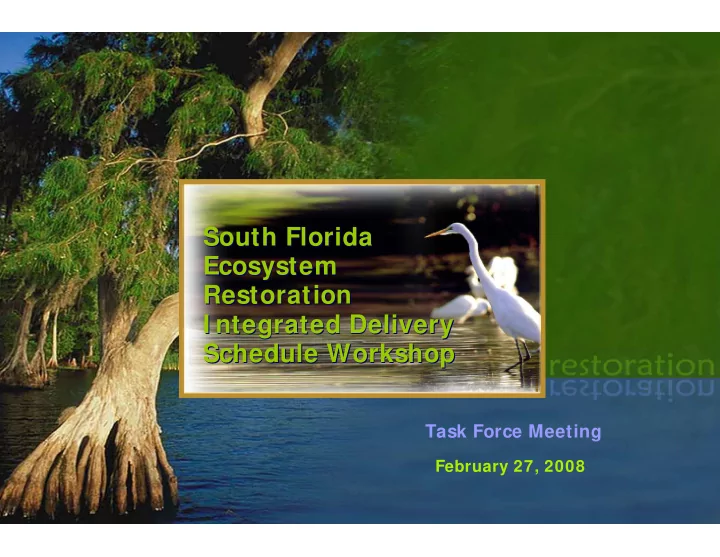

South Florida South Florida Ecosystem Ecosystem Restoration Restoration I ntegrated Delivery I ntegrated Delivery Schedule Workshop Schedule Workshop Task Force Meeting February 27, 2008
Topics Topics � Introduction � Background � Guiding Principles Discussion � Project Matrix Discussion � Issues and Concerns � Next Workshop
Since the December Meeting… � At December Task Force/WRAC meeting, agreement to engage in more intensive effort to develop Integrated Delivery Schedule � Concept paper developed for Integrated Delivery Schedule development process � Team developed read-ahead material for this effort
Desired Outcomes for Today Develop: � A common vision of what the Integrated Delivery Schedule will do � A common set of guiding principles for Integrated Delivery Schedule development � A time table for developing the Integrated Delivery Schedule to include a list of the major actions to be accomplished at future workshop(s)
Background
1999 Yellow Book I mplementation Plan � Contained implementation plan with detailed charts showing sequencing of CERP projects � Based on annual funding level of $200M Federal and $200M non- Federal � 35+ year implementation period, with most projects completed by 2020+ � Coordinated with stakeholders prior to inclusion in Yellow Book
Yellow Book I mplementation Plan $500,000,000 Scenario: $400M Annual Guideline $450,000,000 Projected Funding $400,000,000 Requirement $350,000,000 $300,000,000 $250,000,000 $200,000,000 $150,000,000 $100,000,000 $50,000,000 $0 99 01 03 05 07 09 11 13 15 17 19 21 23 25 27 29 31 33 35 37 Fiscal Year Federal Non-Federal
Master I mplementation Sequencing Plan (MI SP) � Required by Programmatic Regulations � Current version completed in 2005 � MISP defines the order in which the many projects within the South Florida Ecosystem Restoration Program will be planned, designed and constructed � MISP based on banding - grouping of those products and projects to be accomplished within specific 5-year time periods � Includes Acceler8 projects
Acceler8 Projects � Announced by the Governor in October 2004 to provide immediate benefits to the South Florida ecosystem � Cost : $1.5 billion � Majority of the projects were a part of the 10 initially authorized projects in WRDA 2000 � Most of the land already in public ownership – acquired with federal and state partnership funds � Projects are in accordance with the Master Implementation Sequencing Plan
Foundation Projects 2012 2012 Critical Projects 2007 2007 Pilot Projects 2017 2017 Master I mplementation Master I mplementation Surface Storage 2033 2033 Reservoirs Sequencing Plan Sequencing Plan Stormwater 2033 2033 Treatment Areas Seepage 2014 2014 Management Decompartmentalization 2009 2009 Phase I Decompartmentalization 2019 2019 Phase I I Aquifer Storage 2028 2028 & Recovery Wastewater Reuse 2023 2023 I n-ground Storage 2036 2036 Reservoirs Adaptive Assessment 2036 2036 2000 2005 2010 2020 2025 2035 2015 2030 or Prior Fiscal Years Band 1 Band 2 Band 3 Band 4 Band 5 Band 6
NAS Report to Congress � Biennial report required by WRDA 2000 � Recommended Incremental Adaptive Restoration (IAR) approach to accelerate natural system restoration – Make investments that are significant enough to produce benefits while resolving scientific uncertainties � Developing integrated delivery schedule to focus restoration effort
May 2007 GAO Report � Core group of projects behind schedule � No overarching sequencing criteria used for decision- making � Implementation decisions mostly driven by availability of funds � Sequencing plan in 2005 not consistent with criteria established by the Corps – Sequencing driven by technical dependencies
Guiding Principles
Guiding Principles Discussion No CERP projects are being taken off the table � The Integrated Delivery Schedule must acknowledge the Federal and � State commitment to complete implementation of key ongoing projects before initiating construction of new CERP projects Other projects and programs that will require significant continued � resources from State and/or Federal agencies will be accomplished with separate funding sources Projects should be implemented in a sequence that achieves restoration � objectives at earliest possible time, consistent with funding constraints. As appropriate, projects should be broken into multiple PIRs to facilitate � the Incremental Adaptive Restoration (IAR) approach The IDS will be the basis for the updated MISP for CERP � As appropriate, physical dependencies should drive order of projects � As appropriate, the Interim Goals and Targets should be used to � measure restoration progress Key points in implementation will be defined by new system operating � manuals
Project Matrix
Project Matrix � Colored bands on matrix represent projects with Federal and/or State commitment to implement – “what’s on our plate” – Foundation Projects (Green Band) – Accelerated Implementation of CERP Projects (Blue Band) – CERP Pilot Projects (Yellow Band) – CERP Feasibility Studies (Gray Band) – Other Authorized CERP Projects (Pink Band) � Matrix includes remaining CERP projects (White Band) – Project Implementation Reports currently underway – Future CERP Project Implementation Reports � Matrix does not include other projects/programs such as Herbert Hoover Dike Rehabilitation, State Northern Everglades Plan, and State Long-Term Plan for Achieving Water Quality Goals which will be accomplished with separate funding sources
Remaining Commitments FY09 � Federal Non-Federal Foundation Projects $400M $150M (Green Band) Accelerated Implementation – Oct 2004 $700M $1.5B (Blue Band) Accelerated Implementation – Other $190M $130M (Blue Band) CERP Pilot Projects $20M (Yellow Band) CEEP Feasibility Studies $40M $40M (Gray Band) Other Authorized CERP Projects $275M (Pink Band) Total $1.6B $1.8B
Sequencing Discussion Should we: � Target resources on completing projects as soon as possible (i.e. put lots of funds on fewer projects, but complete projects sooner) � Spread resources among a number of projects (i.e. put funds on more projects) � Develop other approaches?
I ssues and Concerns
Closing Three Thoughts Discussion Three closing thoughts from each member on the Integrated Delivery Schedule: � Issues � Concerns � Priorities
Next Steps Discussion
Thank You Thank You
Recommend
More recommend